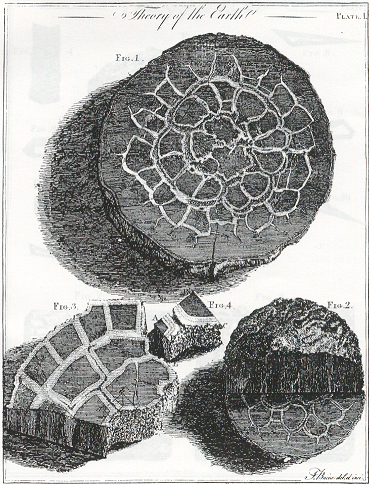( Fr- septarium; Ger- Septarien;
Nor- septarium; Rus- ![]() )
)
SEPTARIUM (plural: SEPTARIA)

A. Septarium (greatest dimension - 14.5 cm) from near the southern end of the common border between Dallas and Tarrant counties, Texas. R.V. Dietrich collection. (photo by D.R. Fisher)
B. Septarium (greater dimension - ca. 14 cm) from an unknown locality, cut to expose internal pattern of septa. (© photo by S. Monroe)
DESCRIPTION: Septaria are concretions that are characterized by the presence of roughly radial and concentric septa that consist of relatively coarse-grained minerals that, in some septaria, enclose open spaces. Most septaria have roughly oblate spheroidal shapes and overall argillitic limestone or dolostone compositions, except for their septa. The coarse-grained "septa" are usually quite evident in field exposures because they tend to weather either more or less deeply than the main parts of these concretions (see Figure A).
USES: Relatively large septaria, sawed in directions that best exhibit the patterns of their "septa," have been used for table tops, bookends, etc. Smaller septaria have been sawed, shaped and polished for use in brooches and for fashioning eggs, small spheres, etc. In addition, both attractive stones fashioned for use in brooches and similar pieces of jewelry and fetishes advertized as "carved by Zunis" have been marketed rather widely.
OCCURRENCES: Most septaria occur in shales, typically carbon-rich shales widely referred to as black shales. Several septaria have have been found weathered out --I.e., free from -- their originally surrounding rocks. Although I have seen no record of their being used as gemrocks, I have often wondered about the septaria Darwin (1844, p.48) described from a "pumiceous tuff" on Ascension Island in the southern Atlantic. -- Were the masses he described perhaps what many people now call thunder eggs?
NOTEWORTHY LOCALITIES: Septaria are relatively common in several sedimentary sequences here and there throughout the world. On the basis of those I have seen, I think that at least some of those from the following localities could be fashioned into especially attractive items such as those listed under the USES subheading: New York -- in scarps along Cayuga Lake between Portland Point on the east side of the lake, north to at least Interlaken near its west side, in Tompkins and Seneca counties, and in the gorge of the Genesee River, Genesee County; Michigan -- here and there in Alpena County; North Dakota -- near the Missouri River, just north of the South Dakota line, in Emmons and Sioux counties; Texas -- near the common border between Dallas and Tarrant counties; Utah --near Orderville, Kane County. In addition, I have seen photographs of some fine examples from Kansas, England, France, and Morocco.
An interesting American Indian legend deals with the origin of septaria within shales that crop out along the east side of Canandaigua Lake, one of the Finger lakes of central New York State. Unfortunately, the length and complexities of this legend, interesting as it is, make it unwise either to quote or to try to summarize here. For those interested, see its essence as recorded by David Jensen (1954).
Large septaria, designated as turtlestones, from the Oxford Clay of Weymouth, southern England, were cut and polished for use as table tops at least as early as the mid-19th century (Damon, 1860, p.25). This use of septaria from other localities persists -- see, for example, Kennedy (1964). Small septaria, called "beetle-stones," were "frequently [cut and polished and] used for brooches in Victorian times" (Arkell and Tomkeieff, 1953, p.6).
The number of septaria identified as "Fossil Turtles," especially in small museums and rock shops never ceases to amaze me. A good example is shown as Figure 42 in the MIMETOLITH file on this web site.
Several minerals have been found to occur as constituents of the septa. Examples include "run of the mill" barite, calcite, dolomite, fluorite, galena, sphalerite and witherite and also a few relatively rare minerals that have been sought, collected and sold to discriminating collectors and museums. Two especially noteworthy examples of the "collectables" are the whewellite crystals and gemmy golden barite crystals from septaria that occur near Elk Creek, Meade County and near Hoover, Butte County, South Dakota (Campbell and Roberts,1986 and Campbell, Campbell and Roberts, 1987).
R. V. Dietrich © 2015
Last
update: 6 July 2005
web page created by Emmett Mason